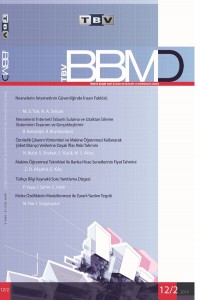Öz
Soru yanıtlama dizgeleri üzerinde
sürdürülen çalışmalar ya bilgi tabanlı ya da genel ağdaki verileri kullanarak
çalışmaktadır. Bu makalede tanıtılan çalışma bilgi tabanlıdır ve Türkçeye
özgüdür. Ural dil ailesinin üyesi olan Türkçe sondan eklemeli bir dildir ve dil
bilgisi kuralları bükünlü Hint-Avrupa dillerinin dil bilgisi kurallarından
farklıdır. Bu nedenle, Türkçe yanıtlama dizgesi Türkçenin dil bilgisi
kurallarına uygun olarak hazırlanmıştır. Dizge sırasıyla şu aşamalardan
oluşmaktadır: Ön işleme (tümcelere ayırma, sözcüklere ayırma, hecelere ayırma,
ses bilimi açısından sınama (ünlü, ünsüz uyumu, ünlü düşmesi, baş ve sondaki
harf kuralları, galatlar ve yabancı sözcükler); Biçim bilimsel çözümleme; Sözcüklerin
sınıflarının belirlenmesi; Söz öbeklerinin bulunması; Sözcüklerin rollerinin
belirlenmesi; Tümcenin anlamlandırılması; Uygun yanıtın üretilmesi. Üretilen
her yanıtın doğruluğu soru soran kişiye onaylatılmaktadır. Sorulan sorular ve
bunlara ilişkin yanıtlar bir koşut derlem içinde tutulmaktadır. Dizge belli bir
süre çalıştırıldıktan sonra söz konusu koşut derlem yeterli boyuta
ulaşmaktadır. Bu aşamadan sonra, sorulan bir sorunun çözümlenmesine geçmek
yerine koşut derlemde aranmakta ve aynı ya da benzer yanıt bulunmaya
çalışılmaktadır. Benzet tümcelerin bulunması için vektör yaklaşımı
kullanılmıştır.
Anahtar Kelimeler
Bilgi tabanlı Soru Yanıtlama Dizgesi Biçim Bilimsel Çözümleme Sonlu Durum Makinesi
Destekleyen Kurum
TÜBİTAK
Proje Numarası
7180222
Kaynakça
- [1] J. Weizenbaum, Computer and Human Reason: From Judgment to Calculation. Pp. XII, 300 San Francisco, California. W. H. Freeman Co, 1976
- [2] X. Li. D. Roth, Learning Question Classifiers, COLING '02 Proceedings of the 19th international conference on Computational linguistics - Volume 1 Pages 1-7, 2002
- [3] X. Li. D. Roth, Learning Question Classifiers: The Role of Semantic Information, Natural Language Engineering 1 (1): 000–000. Cambridge University Press. 2004
- [4] B. Ojokoh, P. Ayokunle, Online Question Answering System, International Journal of Computer Science Research and Application 2013, Vol. 03, Issue. 03, pp. 02-09
- [5] A. Ghobadi, T. M. Rahgozar, A knowledge-based question answering system for B2C eCommerce, Knowledge-Based Systems, Volume 21, Issue 8, December 2008, Pages 946-950, Elsevier
- [6] R. P. de Azevedo, M. J. V. Pereira, P. R. Henriques, DSL Based Automatic Generation of Q&A Systems, WorldCIST'19 2019, AISC 930, pp. 460–471, 2019 Springer Nature Switzerland
- [7] W. Cui, Y. Xiao, H. Wang, Y. Song, S. Hwang, W. Wang, KBQA: Learning Question Answering over QA Corpora and Knowledge Bases, Proceedings of the VLDB Endowment, Vol. 10, No. 5, 2017
- [8] P. J. Paul, S. Amaran, K. S. Kumar, U.M. Prakash, Question Answering System Using the Approach Of NLP, International Journal of Pure and Applied Mathematics, Volume 117 No. 7 2017, 445-458, 2017
- [9] N. Coşkun, Türkçe Tümcelerin Ögelerinin Bulunması, Yüksek Lisans Tezi, İTÜ Fen Bilimleri Ens. 2013
- [10] K. Oflazer, Two-level Description of Turkish Morphology, Bilkent University
- [11] G. Eryiğit, Biçimbilimsel Çözümleme, TBV Bilgisayar Bilimleri ve Mühendisliği Dergisi sayı: 6, 2012
Öz
Proje Numarası
7180222
Kaynakça
- [1] J. Weizenbaum, Computer and Human Reason: From Judgment to Calculation. Pp. XII, 300 San Francisco, California. W. H. Freeman Co, 1976
- [2] X. Li. D. Roth, Learning Question Classifiers, COLING '02 Proceedings of the 19th international conference on Computational linguistics - Volume 1 Pages 1-7, 2002
- [3] X. Li. D. Roth, Learning Question Classifiers: The Role of Semantic Information, Natural Language Engineering 1 (1): 000–000. Cambridge University Press. 2004
- [4] B. Ojokoh, P. Ayokunle, Online Question Answering System, International Journal of Computer Science Research and Application 2013, Vol. 03, Issue. 03, pp. 02-09
- [5] A. Ghobadi, T. M. Rahgozar, A knowledge-based question answering system for B2C eCommerce, Knowledge-Based Systems, Volume 21, Issue 8, December 2008, Pages 946-950, Elsevier
- [6] R. P. de Azevedo, M. J. V. Pereira, P. R. Henriques, DSL Based Automatic Generation of Q&A Systems, WorldCIST'19 2019, AISC 930, pp. 460–471, 2019 Springer Nature Switzerland
- [7] W. Cui, Y. Xiao, H. Wang, Y. Song, S. Hwang, W. Wang, KBQA: Learning Question Answering over QA Corpora and Knowledge Bases, Proceedings of the VLDB Endowment, Vol. 10, No. 5, 2017
- [8] P. J. Paul, S. Amaran, K. S. Kumar, U.M. Prakash, Question Answering System Using the Approach Of NLP, International Journal of Pure and Applied Mathematics, Volume 117 No. 7 2017, 445-458, 2017
- [9] N. Coşkun, Türkçe Tümcelerin Ögelerinin Bulunması, Yüksek Lisans Tezi, İTÜ Fen Bilimleri Ens. 2013
- [10] K. Oflazer, Two-level Description of Turkish Morphology, Bilkent University
- [11] G. Eryiğit, Biçimbilimsel Çözümleme, TBV Bilgisayar Bilimleri ve Mühendisliği Dergisi sayı: 6, 2012
Ayrıntılar
| Birincil Dil | Türkçe |
|---|---|
| Konular | Mühendislik |
| Bölüm | Makaleler(Araştırma) |
| Yazarlar | |
| Proje Numarası | 7180222 |
| Yayımlanma Tarihi | 17 Aralık 2019 |
| Yayımlandığı Sayı | Yıl 2019 Cilt: 12 Sayı: 2 |
Kaynak Göster
https://i.creativecommons.org/l/by-nc/4.0Makale Kabulü | |
Çevrimiçi makale yüklemesi yapmak için kullanıcı kayıt/girişini kullanınız. Dergiye gönderilen makalelerin kabul süreci şu aşamalardan oluşmaktadır: 1. Gönderilen her makale ilk aşamada en az iki hakeme gönderilmektedir. 2. Hakem ataması, dergi editörleri tarafından yapılmaktadır. Derginin hakem havuzunda yaklaşık 200 hakem bulunmaktadır ve bu hakemler ilgi alanlarına göre sınıflandırılmıştır. Her hakeme ilgilendiği konuda makale gönderilmektedir. Hakem seçimi menfaat çatışmasına neden olmayacak biçimde yapılmaktadır. 3. Hakemlere gönderilen makalelerde yazar adları kapatılmaktadır. 4. Hakemlere bir makalenin nasıl değerlendirileceği açıklanmaktadır ve aşağıda görülen değerlendirme formunu doldurmaları istenmektedir. 5. İki hakemin olumlu görüş bildirdiği makaleler editörler tarafından benzerlik incelemesinden geçirilir. Makalelerdeki benzerliğin %25’ten küçük olması beklenir. 6. Tüm aşamaları geçmiş olan bir bildiri dil ve sunuş açısından editör tarafından incelenir ve gerekli düzeltme ve iyileştirmeler yapılır. Gerekirse yazarlara durum bildirilir.
|



